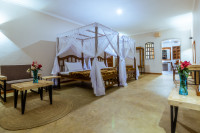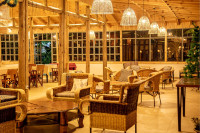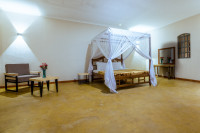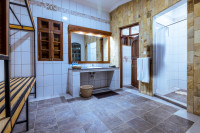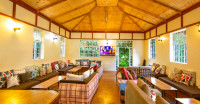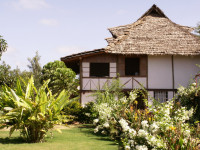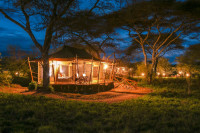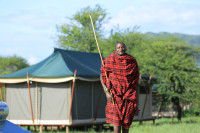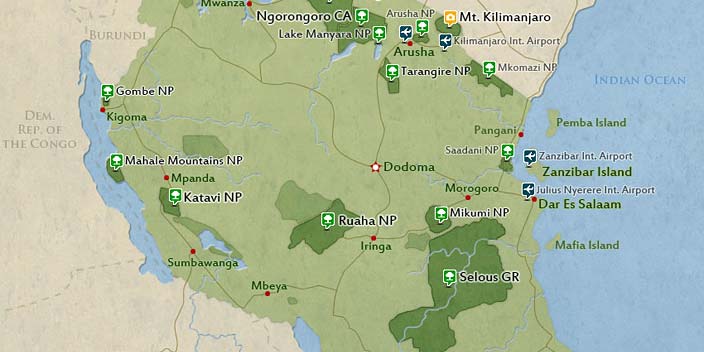
Arrival
Arrival

Day 1
Arrival at the airport to Arusha city
Arrival at the airport to Arusha city
Once you arrive at the airport (Kilimanjaro International Airport or Arusha Airport), you will be met and welcomed by one of our representatives from Wildtrack Expedition and drive you straight to your lodgings in Arusha for overnight, before your safari adventure on the next day.
- Main Destination:
- Arusha (City)
- Accommodation:
- Pazuri Inn
- Meals & Drinks:

Day 2
Arusha to Tarangire National Park (approximately 120km and 2 hours' drive))
Arusha to Tarangire National Park (approximately 120km and 2 hours' drive))
Early morning after breakfast at your lodge in Arusha, you will be picked up by your private safari guide and take you to Tarangire National Park which takes approximately 2 hours. Tarangire National Park is most popular for its large elephant herds and giant baobab trees. It also has a mini-wildlife migration that takes place during the dry season which consists of about 250,000 animals enter the park. More than 300-strong herds of elephant, visitors will find big groups of buffalo and healthy populations of lions and leopards. During the dry season, Tarangire has the highest concentration of mammals in the country. There are wild dogs and rare antelopes such as gerenuk, plus more than 550 species of birds to spot throughout the year. You will have picnic lunch boxes inside the park in the afternoon. After lunch and further game viewing, you will drive straight to your lodge in Karatu for relaxation, dinner and overnight.
- Main Destination:
- Tarangire National Park
- Accommodation:
- Eileen's Trees Inn
- Meals & Drinks:

Day 3
Ngorongoro Crater to Serengeti National Park
Ngorongoro Crater to Serengeti National Park
Early morning after breakfast at your accommodation, you will drive straight to Ngorongoro conservation area whereby you stop at the view point of Ngorongoro crater before you descend down the crater. The Ngorongoro Crater is the world’s largest intact volcanic caldera forming a spectacular bowl of about 265 square kilometres, with sides up to 600 metres deep and is home to approximately 30,000 mammals.
The crater offers a breathtakingly beautiful scenery and is the best place in East Africa to see the ‘Big Five’ (elephant, rhinoceros, buffalo, lion and rarely leopard).
The Ngorongoro Crater offers excellent birding, with over 500 species.
You will have packed picnic lunch boxes and after having lunch at the picnic site, you will ascend the crater and drive straight to your accommodation at the central Serengeti for dinner and overnight.
- Main Destination:
- Ngorongoro Crater
- Accommodation:
- Embalakai Serengeti Camp
- Meals & Drinks:

Day 4
Serengeti National Park to Karatu via Ngorongoro Conservation Area
Serengeti National Park to Karatu via Ngorongoro Conservation Area
Early morning after breakfast, you will proceed with your game drive in Serengeti National Park. Serengeti National Park covers an area of approximately 14,750 square kilometers (5,700 square miles), making it Tanzania's second-largest national park. Often referred to as the "Crown Jewel" of Tanzania's national parks, the park is renowned for its vast grasslands, where millions of wildebeest, zebras, and other herbivores migrate in search of fresh food, attracting large populations of predators, including lions, leopards, and cheetahs. The Great Migration is one of the most spectacular natural events on the planet.
The Serengeti boasts breathtaking landscapes, including the famous kopjes (rock formations), acacia-dotted plains, and the Seronera Valley. These landscapes provide incredible backdrops for wildlife photography.
Lunch will be served inside the park and after that, you will finalize your game drive and head straight to Karatu at your accommodation for dinner and overnight.
- Main Destination:
- Serengeti National Park
- Accommodation:
- Eileen's Trees Inn
- Meals & Drinks:

Day 5
Lake Manyara National Park to Arusha
Lake Manyara National Park to Arusha
Early morning after breakfast at your accommodation, you will drive straight to Lake Manyara National Park. It is known as the home of tree climbing lions as well as the birds’ paradise. Here there is a huge variety of birds including thousands of flamingos, great white pelicans, yellow-billed storks along with smaller numbers of Marabou storks, grey herons, palm-nut vultures, hawks and many more. A huge number of animals can also be spotted inside Lake Manyara like the elephants, wildebeest, zebra, Thomson's gazelle and Grant's gazelles etc. Predators of Lake Manyara National Park include lions, hyena, black-backed jackal etc.
Lunch will be served at a picnic site and after further exploration of the park, you will drive straight to Arusha which marks the end of your adventures with us.
If you would like to have an extra night in Arusha, we can arrange that for you or if you are flying, we will drive you straight to the airport to catch your onwards flight.
- Main Destination:
- Lake Manyara National Park
- Accommodation:
- No accommodation (End of tour)
- Meals & Drinks:


